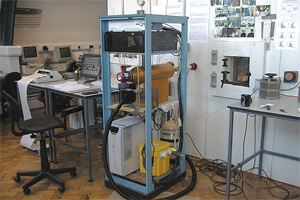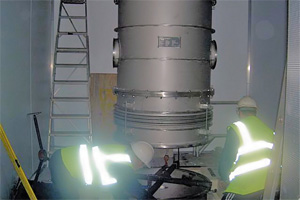Manchester Cloud Physics Lab Studies
For many years, the centre for Atmospheric Science has operated several cold rooms containing cloud chambers which have been used for studies of cloud chemistry, ice crystal growth, the influence of high electric field on cloud, instrument calibration and thunderstorm electrification.

Traditionally these experiments have been performed in relatively small chambers which limited the range of particle sizes which could be studied. A cloud has typically been formed in the chamber by cooling to the desired temperature, injecting water vapour into the chamber until it becomes supersaturated, at which point a droplet cloud forms on the aerosol present in the chamber. To produce an ice cloud, ice crystals were nucleated by introducing a small metal rod which had been cooled in liquid nitrogen into the top of the chamber thus initiating the glaciation process. The controlled conditions of the chamber allowed the properties such as crystal habit of the cloud produced to be studied. Mixed phase clouds have been studied by separating a chamber into two compartments, forming a cloud in both, but only initializing glaciation in one compartment. Once fully glaciated the partition is removed allowing the different clouds to mix.
The clouds produced in the chamber are characterized by drawing particles from the chamber through a sampling system capable of measuring the properties of the particles. The formvar replica technique has been used extensively for this type of work. Here crystals (or drops) are collected onto a slide coated with a liquid formvar layer (or other substance), in which they become encased. The formvar layer sets, and cloud particles evaporate, leaving a hollow replica of crystals in the formvar layer. These replicas are then sized and classified manually, or with automatic software under an optical microscope. More recently the same cloud probes which are used for ground based and airborne studies have been used to characterize cloud particles produced in the chambers. The Cloud Particle Imager has been used extensively mounted externally to the chamber to measure ice crystals produced in the experiment. Droplet probes have also been used internally and externally to measure the size distribution of supercooled droplets.
Electrification of thunderstorms has been a long running research theme at the University of Manchester (and within the cloud physics community). This work involves research flights through electrified storms to determine cloud particle properties, their electric charges and the resulting electric field. In the laboratory in Manchester thunderstorm conditions are simulated in the cloud chamber in order to measure charge transfer when ice crystals collide with small hailstones. Extensive studies here have shown this to be a likely thunderstorm charging mechanism. For these experiments cloud particles formed in the chamber are drawn past a small rod representative of a hailstone and the charge accumulated on the rod is measured.

The centre’s new laboratory facilities in the Simon Engineering building include a substantial investment in new cloud chamber facilities. These new facilities allow new types of experiment to be performed as well as allowing a continuation of previous work. With the new chamber it is possible to: study interactions between much larger ice crystals; study clouds at temperatures and pressures representative of those in the stratosphere; form a cloud by cooling due to adiabatic expansion (as is the case in the atmosphere); control the aerosol population on which the cloud forms. It is hoped that these more realistic studies will help us gain greater understanding of ice cloud chemical and physical processes.
In addition to cloud studies, the cloud chamber is also used for instrument testing and calibration. In order to successfully compare measurements made with different instruments on multiple platforms it is important to know how these instruments compare when they are known to be sampling under the same conditions. While some intercomparisons can be done in the field using intercomparison flights and fly-bys over ground stations, these methods provide limited datasets and often leave uncertainty over the conditions sampled (close formation flying and flight close to ground level is not generally permitted while in cloud). The cloud chamber provides a convenient and cost effective method of simultaneously comparing multiple instruments under a variety of controlled cloud conditions. To date the facility has been used to inter-compare droplet and ice particle instruments belonging to the University of Manchester, FAAM, the UK Met Office and the US Department of Energy.